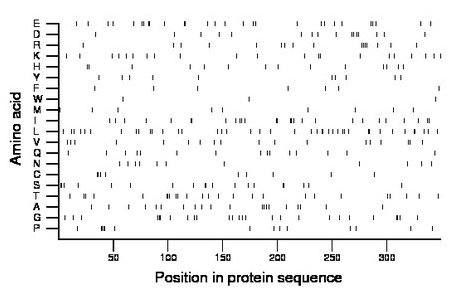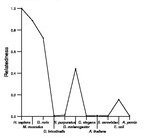
| Name: PTER | Sequence: fasta or formatted (349aa) | NCBI GI: 47933341 | |
|
Description: phosphotriesterase related
|
Referenced in:
| ||
Other entries for this name:
alt mRNA [349aa] phosphotriesterase related | |||
|
Composition:

Amino acid Percentage Count Longest homopolymer A alanine 5.7 20 1 C cysteine 2.6 9 2 D aspartate 4.6 16 2 E glutamate 8.0 28 2 F phenylalanine 2.0 7 1 G glycine 7.4 26 3 H histidine 4.0 14 1 I isoleucine 7.7 27 2 K lysine 6.0 21 2 L leucine 11.7 41 2 M methionine 2.6 9 1 N asparagine 3.2 11 1 P proline 4.0 14 4 Q glutamine 4.3 15 1 R arginine 4.6 16 2 S serine 5.4 19 2 T threonine 7.2 25 3 V valine 5.2 18 2 W tryptophan 0.9 3 1 Y tyrosine 2.9 10 1 |
Comparative genomics:
Search single species RefSeq proteins at NCBI
Search summary 
Figure data | ||
Related human proteins:Protein Relative score Description Self-match 1.000 phosphotriesterase related PTER 1.000 phosphotriesterase related ZFP106 0.010 zinc finger protein 106 homolog RAD51L1 0.010 RAD51-like 1 isoform 3 DTX2 0.007 deltex 2 isoform b DTX2 0.007 deltex 2 isoform a DTX2 0.007 deltex 2 isoform a DTX2 0.007 deltex 2 isoform a CHN1 0.007 chimerin (chimaerin) 1 isoform a CHN1 0.007 chimerin (chimaerin) 1 isoform b RAD51L1 0.007 RAD51-like 1 isoform 2 RAD51L1 0.007 RAD51-like 1 isoform 1 DMXL1 0.006 Dmx-like 1 KRT18 0.006 keratin 18 KRT18 0.006 keratin 18 LOC100133890 0.006 PREDICTED: similar to Shank2E LOC100287203 0.006 PREDICTED: hypothetical protein LOC100287203 0.006 PREDICTED: hypothetical protein XP_002342370 SHANK2 0.006 SH3 and multiple ankyrin repeat domains 2 isoform 1... AFG3L2 0.006 AFG3 ATPase family gene 3-like 2 RNF14 0.006 ring finger protein 14 isoform 1 RNF14 0.006 ring finger protein 14 isoform 1 RNF14 0.006 ring finger protein 14 isoform 1 RNF14 0.006 ring finger protein 14 isoform 2 RNF14 0.006 ring finger protein 14 isoform 1 PYGL 0.004 liver glycogen phosphorylase MPHOSPH6 0.004 M-phase phosphoprotein 6Human BLASTP results (used to prepare the table) | |||
Gene descriptions are from NCBI RefSeq. Search results were obtained with NCBI BLAST and RefSeq entries. When identical proteins are present, the self-match may not be listed first in BLASTP output. In such cases, the table above has been reordered to place it first.
See About the Figures for the scoring system used in the figure above right. The same scoring system was used in the table of BLASTP results.
Guide to the Human Genome
Copyright © 2010 by Stewart Scherer. All rights reserved.
